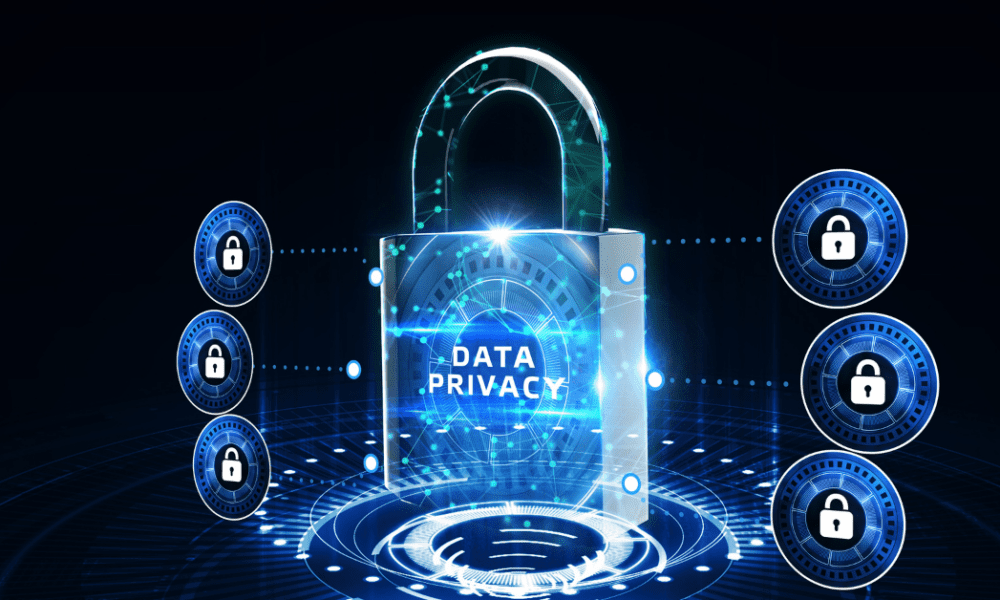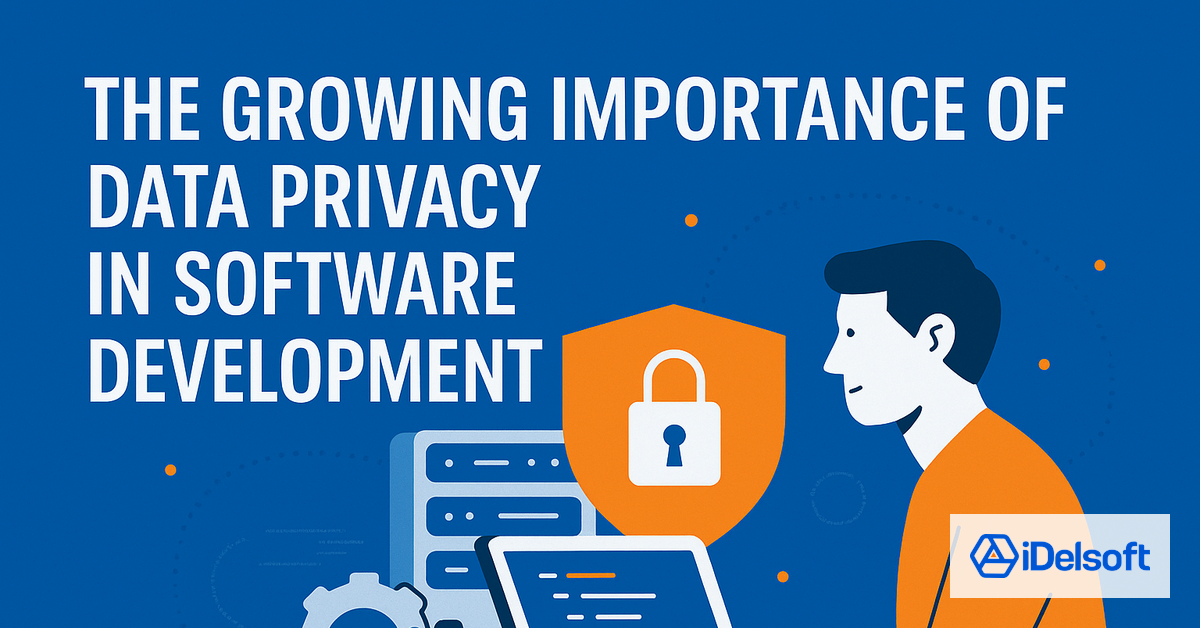Data has become the digital economy’s most valuable resource—fueling personalization, predictive analytics, and AI‑driven insights. Yet scandals such as Cambridge Analytica, high‑profile ransomware attacks, and sweeping regulations (GDPR, CCPA, LGPD) have red‑flagged one hard truth: If your product mishandles personal data, trust evaporates—and so can your business. Today, every software team, no matter its size, must treat data privacy as a first‑class feature, not an after‑thought.
By 2025, privacy is tightly tied to security and AI governance. Regulators, investors, and enterprise customers no longer separate “security,” “compliance,” and “responsible AI”—they expect your product to handle all three coherently, with clear guardrails around how user data is collected, processed, and shared with models and third parties.

Table of Contents
- Why Data Privacy Has Become Mission‑Critical
- A Quick Primer on Global Privacy Regulations
- Core Principles of Privacy‑by‑Design
- Practical Steps for Developers and Architects
- Tooling and Frameworks That Simplify Compliance
- Privacy in DevOps: Shifting Left and Shifting Right
- Handling Third‑Party Services and SDKs
- Small‑Business Considerations and Budget‑Friendly Tips
- Common Pitfalls (and How to Avoid Them)
- Future Trends: What to Watch Over the Next Five Years
- Final Takeaways
1. Why Data Privacy Has Become Mission‑Critical
- Regulatory Fines Are Sky‑High – GDPR penalties can reach 4 % of global annual revenue; even SMBs have been fined five‑figure sums.
- Consumer Trust Is Fragile – 80 % of users say they’ll abandon a brand after a single data‑misuse incident (Cisco 2024 Privacy Benchmark).
- Enterprise Procurement Demands Proof – B2B buyers increasingly require SOC 2, ISO 27001, or GDPR compliance before signing contracts.
- Competitive Advantage – Transparent privacy practices can differentiate your product in a crowded SaaS landscape.
- AI & Data Ethics Are Now Deal-Breakers – Many enterprises ask explicitly how you train, fine-tune, or prompt AI systems using customer data. Poor answers here can kill deals as fast as a missing SOC 2 report.
2. A Quick Primer on Global Privacy Regulations
- GDPR (EU) – Extraterritorial reach; strict consent, data‑subject rights, and breach‑notification windows.
- CCPA/CPRA (California) – Opt‑out of sales/sharing, expanded consumer rights, and fines per record.
- LGPD (Brazil) – Mirrors GDPR but includes local‑storage mandates.
- PIPL (China) – Requires local data‑storage and cross‑border transfer assessments.
- India DPDP Act 2023 – Broad notice‑and‑consent rules with steep penalties.
If you have users anywhere in these jurisdictions, their rules apply—yes, even to five‑person startups.
And it doesn’t stop there: several U.S. states (e.g., Colorado, Virginia, Connecticut, Utah, and others) have rolled out GDPR-inspired laws, while sector-specific rules (healthcare, finance, children’s data) keep tightening. On top of that, the EU AI Act is pushing teams to document how AI systems use and protect personal data, especially for “high-risk” use cases.
And it doesn’t stop there: several U.S. states (e.g., Colorado, Virginia, Connecticut, Utah, and others) have rolled out GDPR-inspired laws, while sector-specific rules (healthcare, finance, children’s data) keep tightening. On top of that, the EU AI Act is pushing teams to document how AI systems use and protect personal data, especially for “high-risk” use cases.

3. Core Principles of Privacy‑by‑Design
- Data Minimization – Collect only what’s necessary; justify each field in every form.
- Purpose Limitation – Use data strictly for stated, user‑approved purposes.
- Security by Default – Encrypt data in transit and at rest; enforce least‑privilege access controls.
- Transparency – Provide clear privacy notices; no dark‑pattern consent banners.
- User Control – Easy mechanisms for data export, correction, and deletion.
- Accountability – Maintain detailed processing records and audit trails.
A practical way to apply privacy-by-design in busy teams: treat every new feature as a mini data-processing activity. For each new endpoint, event, or SDK, ask:
- What data is collected?
- Why do we need it?
- How long do we keep it?
- Who can see it—internally and externally?
If nobody can answer clearly, you’re not ready to ship.
4. Practical Steps for Developers and Architects
Define Data‑Classification Schemes
Tag data as Public, Internal, Confidential, or Sensitive in ticket descriptions and database schemas.
Adopt Secure Coding Practices
- Validate inputs (server‑side).
- Hash & salt passwords (bcrypt, Argon2).
- Rotate secrets via vault services (AWS Secrets Manager, HashiCorp Vault).
Build APIs with Privacy in Mind
- Use field‑level encryption for especially sensitive properties (e.g., SSNs).
- Implement rate limiting and logging that masks PII.
Implement Granular Access Controls
- RBAC or ABAC with least‑privilege defaults.
- Time‑bound access tokens for debugging in production.
Provide Data‑Subject Rights Endpoints
- /export-data to deliver machine‑readable personal data.
- /delete-me workflow with soft delete followed by hard purge.
Don’t forget analytics & logging:
- Avoid dumping raw PII into logs, APM tools, and error trackers.
- Use structured logging with redaction (e.g., mask emails, IDs, tokens).
- Review your analytics events regularly and remove fields you no longer need.

5. Tooling and Frameworks That Simplify Compliance
- OWASP ASVS & Cheat Sheets – Framework‑agnostic security controls.
- Django GDPR API, Rails GDPR Kit, Express‑GDPR – Facilitate user‑data exports and deletions.
- Terraform + Sentinel – Enforce privacy guardrails at infrastructure‑as‑code stage.
- Data‑mapping platforms (e.g., OneTrust, Securiti.ai) for enterprise‑scale inventory.
Additional modern helpers:
- Static & dynamic scanners like Semgrep rulesets for secrets/PII detection.
- Cloud DLP tools (AWS Macie, GCP DLP, etc.) to automatically discover sensitive data in buckets and warehouses.
- Consent-management platforms that integrate directly with your front-end and tag managers, so analytics and ad pixels only fire after valid consent.
6. Privacy in DevOps: Shifting Left and Shifting Right
- Shift Left – Add privacy threat‑modeling to backlog refinement; integrate static analysis tools (Semgrep, Checkmarx) into CI.
- Shift Right – Implement runtime data‑loss‑prevention (DLP) monitoring, anomaly alerts, and automatic token revocation.
A simple pattern:
- During design → identify data types, locations, and flows.
- During build/test → lint for secrets/PII, run SAST/DAST, and unit test data-subject workflows (export/delete).
- During run → monitor access to sensitive tables, alert on unusual export/query behavior, and rehearse incident-response playbooks.
7. Handling Third‑Party Services and SDKs
- Vendor Risk Assessments – Map data flows before installing a single analytics snippet.
- Data Processing Agreements (DPAs) – Require sub‑processors to adhere to equivalent privacy standards.
- Feature Flags – Load third‑party scripts (e.g., Hotjar) only after explicit consent.
Beware “shadow SDKs” in mobile apps that quietly siphon data—Apple and Google now enforce privacy manifest disclosures.
In 2025, it’s also important to:
In 2025, it’s also important to:
- Regularly re-audit your vendor list—many companies discover they still send data to tools nobody uses anymore.
- Prefer vendors that support data residency options, granular data export/delete APIs, and clear AI-usage disclosures.
8. Small‑Business Considerations and Budget‑Friendly Tips
- Start with privacy policies generated via Termly or Iubenda, then refine with counsel as you scale.
- Use open‑source DLP (e.g., Wazuh) and free tiers of cloud KMS for encryption.
- Leverage privacy‑preserving analytics like Plausible or Fathom instead of fingerprinting‑heavy ad pixels.
- Train staff with concise, scenario‑based workshops rather than expensive certifications at the outset.
9. Common Pitfalls (and How to Avoid Them)
- Collect‑Everything Mindset – “We’ll use it later” is no longer viable; delete or anonymize unused data.
- Static Consent Banners – Consent must be granular; bundle toggles by purpose.
- Staging Data Re‑Use – Copying production data into lower environments breaches privacy; generate synthetic data instead.
- Forgotten Backups – Remember to delete or encrypt retired backups containing PII.
- One‑and‑Done Compliance – Regulations evolve; review policies and data maps at least annually.
Other modern traps:
- Unreviewed AI integrations – Piping chat logs or tickets straight into third-party AI tools without clear data-sharing rules.
- Over-privileged support tools – Giving customer-support dashboards “god mode” access to all accounts.
- Orphaned exports – CSVs with PII sitting on someone’s laptop or in random shared folders.
Good hygiene here is often the difference between a minor incident and a full-blown breach.
10. Future Trends: What to Watch Over the Next Five Years
- Global Interoperability – ISO/IEC 27701 gaining traction as a unified privacy framework.
- Privacy Enhancing Technologies (PETs) – Differential privacy, homomorphic encryption, secure multi‑party computation enabling analytics on encrypted data.
- AI‑Driven Data Discovery – ML tools auto‑classifying PII across warehouses.
- Decentralized Identity (DID) – Users controlling verifiable credentials via blockchain wallets.
- US Federal Privacy Law – A nationwide act could harmonize state patchwork within this decade.
Expect also:
- Tighter AI regulations around model training data, synthetic data, and automated decision-making.
- Increased alignment between security certifications (SOC 2, ISO 27001) and privacy frameworks (GDPR, 27701), making integrated audits more common.
11. Final Takeaways
- Data privacy is no longer optional; it’s a critical value proposition.
- Embed privacy‑by‑design from user‑story creation through CI/CD pipelines.
- Stay current with global regulations—even small apps can attract international users overnight.
- Leverage frameworks, automation, and cost‑effective open‑source tools to streamline compliance.
- Build a culture of accountability—every commit, config, and support ticket touches user trust.
When you treat privacy as a product feature—not a legal afterthought—you transform risk into competitive advantage, winning user loyalty and opening enterprise doors.
The playbook for 2025 is simple, but non-negotiable:
Teams that do this consistently not only avoid fines and crises—they become the vendors everyone prefers to work with.
The playbook for 2025 is simple, but non-negotiable:
- Know what data you have and why.
- Minimize and protect it with modern tools.
- Give users real control and clear explanations.
- Prove your practices to customers, auditors, and regulators.
Teams that do this consistently not only avoid fines and crises—they become the vendors everyone prefers to work with.
Looking to scale more efficiently? Connect with iDelsoft.com! We specialize in developing software and AI products, while helping startups and U.S. businesses hire top remote technical talent—at 70% less than the cost of a full-time U.S. hire. Schedule a call to learn more!





